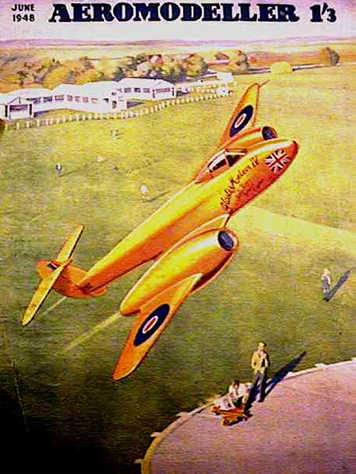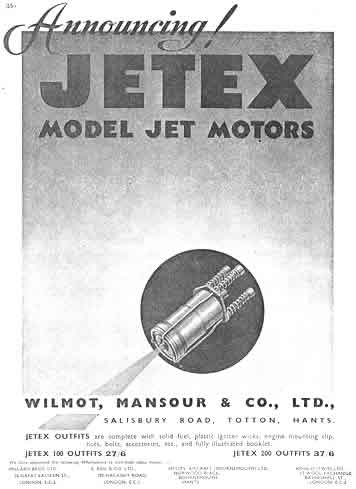In England in 1947, Charles Wilmot and Joe Mansour were developing a
micro rocket motor for model aeroplanes.
The name "Jetex" seems to have been coined towards the end of that year. Certainly, their
first advertisement appeared in
Aeromodeller magazine, in June
1948, with a cover
story and two plans, for a scale Gloster Meteor (below) and a Zephyr duration model.

 The cover painting was by renowned aeronautical artist C. Rupert
Moore and depicted a Gloster Meteor
model in flight. It
was a balsa block design, powered by
twin Jetex 100 engines.
The cover painting was by renowned aeronautical artist C. Rupert
Moore and depicted a Gloster Meteor
model in flight. It
was a balsa block design, powered by
twin Jetex 100 engines.
|
Wilmot Mansour claimed in that first Jetex advertisement that "Jetex 'Space Age' miniature jet
reaction engines provide the latest scientific
form of power. Jetex engines have an unlimited
variety of scientific as well as recreational
uses; they may be installed easily and safely
in most any form of model aircraft, boat, or
car."
|
 |
 |
 |

 The first Jetex advertisement,
from that same issue. The two engines on offer were the
100 and the 200.
Aeromodeller's reviewer considered the
new engines expensive,
priced as they were at 27/6d and
37/6d.
The first Jetex advertisement,
from that same issue. The two engines on offer were the
100 and the 200.
Aeromodeller's reviewer considered the
new engines expensive,
priced as they were at 27/6d and
37/6d.
|
The first motor produced, the 100,
developed approximately 1 ounce (28 g) static
thrust and weighed 7/8 ounce (25 g) loaded.
It was priced at 27/6d and its larger sibling, the 200, at 37/6d – about half the price
of a small diesel model aeroplane engine at that
time. As diesel fuel was so much cheaper per
flight, Aeromodeller magazine was rather dismissive of Jetex as "expensive to
fly".
In late 1948, the
larger 350 motor arrived, followed by the
overwhelmingly popular 50 size in May 1949.
The 50 outfit cost just 10/6d, equivalent to about eight copies of
Aeromodeller magazine. It came attractively packaged in a yellow
box, which would come to be regarded as classically Jetex.
|

